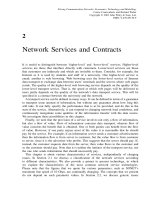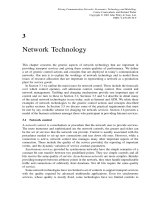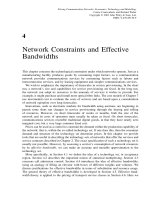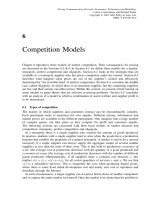Tài liệu Pricing communication networks P1 docx
Bạn đang xem bản rút gọn của tài liệu. Xem và tải ngay bản đầy đủ của tài liệu tại đây (151.63 KB, 21 trang )
Part A
Networks
Pricing Communication Networks: Economics, Technology and Modelling.
Costas Courcoubetis and Richard Weber
Copyright
2003 John Wiley & Sons, Ltd.
ISBN: 0-470-85130-9
1
Pricing and Communications
Networks
This chapter describes current trends in the communications industry. It looks at factors that
influence pricing decisions in this industry, and some differing and conflicting approaches
to pricing. Section 1.1 is about the market for communications services. Section 1.2 is
about present developments in the marketplace. Section 1.3 is about issues that pricing
must address. Section 1.4 presents some introductory modelling.
1.1 The market for communications services
1.1.1 The Communications Revolution
We are in the midst of a revolution in communications services. Phenomenal advances in fi-
bre optics and other network technology, enhanced by the flexible and imaginative software
glue of the World Wide Web have given network users a technology platform that supports
many useful and exciting new services. The usefulness of these services is magnified be-
cause of network externality. This is the notion that a network’s value to its users increases
with its size, since each of its users has access to more and more other users and services.
This is one of the facts that spurs the drive towards worldwide network connectivity and
today’s Internet revolution — a revolution which is changing the way we engage in politics,
social life and business. It is said that the electronic-economy, based as it is upon commu-
nications networks that provide businesses with new ways to access their customers, is des-
tined to be much more than a simple sector of the economy. It will someday be the economy.
In a world that is so thoroughly changing because of the impact of communications
services, the pricing of these services must play an important role. Of course a price must
be charged for something if service providers are to recover their costs and remain in
business. But this is only one of the many important reasons for pricing. To understand
pricing’s other roles we must consider what type of product are communications services
and the characteristics of the industry in which they are sold.
1.1.2 Communications Services
The number of connections that can be made between n users of a network is
1
2
n.n1/.This
gives us Metcalf’s Law (named after the inventor of Ethernet), which says that the value of
Pricing Communication Networks: Economics, Technology and Modelling.
Costas Courcoubetis and Richard Weber
Copyright
2003 John Wiley & Sons, Ltd.
ISBN: 0-470-85130-9
4 PRICING AND COMMUNICATIONS NETWORKS
a network increases as the square of the number of users. It relates to the idea of network
externality and the fact that a larger network has a competitive advantage over a smaller one,
because each of the larger network’s users can communicate with a greater number of other
users. It makes the growth of a large customer base especially important. With this in mind,
a network operator must price services attractively. In this respect, communications services
are like any economic good and fundamental ideas of the marketplace apply. One of these
is that deceasing price increases demand. Indeed, it is common for providers to give away
network access and simple versions of network goods for free, so as to stimulate demand
for other goods, build their customer base and further magnify network externality effects.
The above remarks apply both to modern networks for data communication services
and to the traditional telecommunications networks for voice services, in which the former
have their roots. Throughout this book we use the term ‘telecommunications’ when referring
specifically to telephony companies, services, etc., and use the broader and encompassing
term ‘communications’ when referring both to telephony, data and Internet. It is interesting
to compare the markets for these networks. For many years the telecommunications market
has been supplied by large regulated and protected monopolies, who have provided users
with the benefits of economy of scale, provision of universal service, consistency and
compatibility of technology, stable service provision and guaranteed availability. Services
have developed slowly; demand has been predictable and networks have been relatively easy
to dimension. Prices have usually been based upon potential, rather than actual, competition.
In comparison, the market for modern communications services is very competitive and
is developing quite differently. However, the markets are alike in some ways. We have
already mentioned that both types of network are sensitive to network externality effects.
The markets are also alike is that in that network topology restricts the population
of customers to whom the operator can sell and network capacity limits the types and
quantities of services he can offer. Both topology and capacity must be part of the operator’s
competitive strategy. It is helpful to think of a communications network as a factory which
can produce various combinations of network services, subject to technological constraints
on the quantities of these services that can be supported simultaneously. Severe congestion
can take place if demand is uncontrolled. A central theme of this book is the role of
pricing as a mechanism to regulate access to network resources and restrict congestion to
an acceptable level.
Traditional telecoms and modern data communications are also alike in that, once a net-
work of either type is built, the construction cost is largely a fixed cost, and the variable oper-
ating costs can be extremely small. If there is no congestion, the marginal cost of providing
a unit of communications service can be almost zero. It is a rule of the marketplace that com-
petition drives prices towards marginal cost. Thus, a danger for the communications industry
is that the prices at which it can sell communications services may be driven close to zero.
In summary, we have above made three elementary points about pricing: lowering price
increases demand; pricing can be used to control congestion; competition can drive prices
to marginal cost.
1.1.3 Information Goods
It is interesting to compare communications services with information goods,suchasCDs,
videos or software. These share with communications services the characteristic of being
costly to produce but cheap to reproduce. The first copy of a software product bears all the
production cost. It is a sunk cost, mainly of labour. Many further copies can be produced
THE MARKET FOR COMMUNICATIONS SERVICES 5
at almost no marginal cost, and if the software can be distributed on the Internet then its
potential market is the whole Internet and its distribution cost is practically zero. Similarly,
once a network is built, it costs little to provide a network service, at least while there is no
congestion. This also shows that information goods and network services can sometimes
be viewed as public goods, like highways. Assuming that the installed network capacity is
very large (which is nearly true given today’s fibre overprovisioning), the same information
good or network service can be consumed by an arbitrary number of customers, increasing
its value to its users (due to externalities) and the value to society. This is in contrast to
traditional goods like oranges and power; a given orange or kilowatt-hour can be consumed
by a single customer and there is a cost for producing each such additional unit.
The similarity cannot be pushed too far. We must not forget that a network has a
continuing running cost that is additional to the one-time cost of installation. This includes
network management operations, amongst which accounting and billing are particularly
costly. The cost of selling a single copy of a piece of software is small compared to the
cost of maintaining, monitoring and billing a network service. It is not surprising that cost,
among many other economic factors, influences the evolution of networking technology.
One reason for the acceptance of Internet technology and the Internet Protocol (IP) is that
there it is less costly to manage a network that is based on a single unifying technology,
than one that uses layers of many different technologies.
There are some lessons to be learned from the fact that information goods can sell at both
low and high prices. Consider, for example, the fact that there are hundreds of newspaper
web sites, where entertaining or useful information can be read for free. It seems that
publishers cannot easily charge readers, because there are many nearly equivalent sites. We
say that the product is ‘commoditized’. They may find it more profitable to concentrate
on differentiating their sites by quality of readership and use this in selling advertising.
In contrast, a copy of a specialist software package like AutoCad can sell for thousand of
dollars. The difference is that its customer base is committed and would have difficulty
changing to a competing product because the learning curve for this type of software
is very steep. Similarly, Microsoft Word commands a good price because of a network
externality effect: the number of people who can exchange documents in Word increases
as the square of the number who use it. These examples demonstrate another important
rule of the marketplace: if a good is not a commodity, and especially if it has committed
customers, then it can sell at a price that reflects its value to customers rather than its
production cost.
We have noted that both traditional telecoms and modern communications services are
sensitive to network topology and congestion. This is not so for an information good. The
performance of a piece of software running on a personal computer is not decreased simply
because it is installed on other computers; indeed, as the example of Microsoft Word shows,
there may be added value if many computers install the same software.
1.1.4 Special Features of the Communications Market
One special feature of the market for communications services, that has no analogy in the
market for information goods (and only a little in the market for telecommunications), is
that in their most basic form all data transport services are simply means of transporting
data bits at a given quality level. That quality level can be expressed such terms as the
probability of faithful transmission, delay and jitter. A user can buy a service that the
operator intended for one purpose and then use it for another purpose, provided the quality
6 PRICING AND COMMUNICATIONS NETWORKS
level is adequate. Or a user can buy a service, create from it two services, and thereby pay
less than he would if he purchased them separately. We say more about the impact of such
substitutability, arbitrage and splitting upon the relative pricing of services in Section 8.3.5.
Another thing that makes communication transport services special is their reliance on
statistical multiplexing. This allows an operator to take advantage of the fact that data traffic
is often bursty and sporadic, and so that he can indulge in some amount of overbooking. He
need not reserve for each customer a bandwidth equal to that customer’s maximum sending
rate. Statistical multiplexing produces economy of scale effects: the larger the size of the
network, the more overbooking that can take place, and thus the size of the customer base
that can be supported increases more than proportionally to the raw quantity of network
resources. It is intuitive that a network service that is easier to multiplex should incur a
lesser charge than one which is more difficult to multiplex. There are many multiplexing
technologies and each is optimized for a particular type of data traffic. For instance, SONET
(Synchronous Optical NETwork) is a multiplexing technology that is optimized for voice
traffic (which is predictable and smooth), whereas the Internet technology is optimized for
data traffic (which is stochastic and bursty).
Simple economic goods are often specified by a single parameter, such as number of
copies, weight, or length of a lease. In contrast, contracts for data communications services
are specified by many parameters, such as peak rate, maximum throughput and information
loss rate. Contracts for services that support multimedia applications are specified by
additional parameters, such as ability to sustain bursty activity, and ability and responsibility
to react to changing network conditions. Since service contracts can be specified in terms
of so many parameters, their potential number is huge. This complicates pricing. How are
we to price services in a consistent and economically rational way? Moreover, contracts
are more than simple pricing agreements. For example, a contract might give a user the
incentive to smooth his traffic. Customers also benefit because the quality of the service
can be better and lower priced. This poses questions of how we can reasonably quantify
a customer’s network usage and price contracts in a way that makes pricing a mechanism
for controlling usage.
1.2 Developments in the marketplace
In the next two sections, we look at some important factors that affect the present market
for communications services. We make some further arguments in favour of the importance
of pricing. We describe the context in which pricing decisions occur, their complexity and
consequences. Some of these issues are subject to debate, and will make most sense to
readers who are familiar with present trends in the Internet. Some readers may wish to skip
the present section on first reading.
There have been two major developments in the marketplace for telecoms services: the
development of cost-effective optical network technologies, allowing many light beams to
be packed in a single fibre; and the widespread acceptance of the Internet protocols as the
common technology for transporting any kind of digitized information. Simultaneously, the
Internet bubble of late 1990s has seen an overestimation of future demand for bandwidth and
overinvestment in fibre infrastructure. Together, these factors have created a new technology
of such very low cost that it threatens to disrupt completely the market of the traditional
telephone network operators, whose transport technologies are optimized for voice rather
than data. It has also commoditized the market for transport services to such an extent that
companies in that business may not be able to recover costs and effectively compete.
DEVELOPMENTS IN THE MARKETPLACE 7
One reason for this is that the Internet is a ‘stupid’ network, which is optimized for
the simple task of moving bits at a single quality level, irrespective of the application
or service that generates them. This makes the network simple and cheap. Indeed, the
Internet is optimized to be as efficient as possible and to obey the ‘end-to-end principle’.
To understand this principle, consider the function: ‘recovery from information loss’. This
means something different for file transfer and Internet radio. The end-to-end principle
says that if such a function is invoked rarely, and is not common to all data traffic, then
it is better to install it at the edge of the network, rather than in each link of the network
separately. Complexity and service differentiation is pushed to the edges of the network.
The reduction in redundancy results in a simpler network core. Customer devices at the
edges of the network must provide whatever extra functionality is needed to support the
quality requirements of a given application.
The fact that the Internet is stupid is one of the major reasons for its success. However,
it also means that a provider of Internet backbone services (the ‘long-haul’ part of the
network, national and international) is in a weak bargaining position if he tries to claim any
substantial share of what a customer is prepared to pay for an end-to-end transport service,
of which the long-haul service is only a part. That service has been commoditized, and so
in a competitive market will be offered at near cost. However, as noted previously, the cost
of building the network is a sunk cost. There is only a very small variable cost to offering
services over an existing network infrastructure. The market prices for network services
will be almost zero, thus making it very difficult for the companies that have invested in the
new technologies to recover their investments and pay their debts. As some have said, the
best network is the hardest one to make money running (Isenberg and Weinberger, 2001).
This ‘paradox of the best network’ does not surprise economists. As we have already
noted, there is little profit to be made in selling a commodity. The telephone network is quite
different. Customers use only simple edge devices (telephones). All value-added services
are provided by the network. Network services are constructed within the network, rather
than at the edges, and so operators can make money by being in control. Similarly, video
and television distribution use service-specific networks and make good profits. Telephone
networks are optimized for voice and not for data. Voice streams are predictable in their
rates, while data is inherently bursty. Due to the overspecified requirements (for reliability
and voice quality), the technologies for voice networks (SONET and SDH) are an order of
magnitude more expensive than the technology for providing simple bit moving services
of comparable bandwidth, as provided by the Internet using the new optical transmission
technologies. The extra quality per bit offered by telephone network infrastructures does not
justify their substantially greater costs. Moreover, the large network capacity available may
let the quality of the bits provided by the new Internet technology networks approach that
provided by the telephone network. Unfortunately, these voice-centred technologies are not
so old as to be easily written-off. Existing operators invested heavily in them during the late
1980s and mid 1990s, encouraged by regulators who allowed them a ‘return on assets’, that
is, a profit proportional to the assets under their control. This makes it hard for operators
to abandon their voice-centred infrastructures and build new networks from scratch.
The above arguments suggest that network operators deploying the new Internet over
fibre technologies should be able to carry voice at substantially less cost than traditional
network operators, and so drive them out of business. They will also be able to offer a rich
set of high bandwidth data services, which are again cheaper for them to provide.
However, things are not entirely rosy for these new network operators. They have
their own problem: namely, a bandwidth glut. During the Internet bubble of the late
8 PRICING AND COMMUNICATIONS NETWORKS
1990s investors overestimated the growth in the demand for data services. They believed
there would be an unlimited demand for bandwidth. Many companies invested heavily in
building new fibre infrastructures, at both the metropolitan and backbone level. DWDM
(Dense Wavelength Division Multiplexing) made it possible to transport and sell up to 80
multiple light waves (using present technology) on a single strand of fibre. Gigabit Ethernet
technologies combined with the Internet protocols allowed connectivity services to be
provided very inexpensively over these fibre infrastructures. Using present technologies each
light wave can carry up to 10 Gbps of information, so that a single fibre can carry 800 Gbps.
Although DWDM is presently uneconomic in the metropolitan area, it makes sense in the
long-haul part of the network. It has been estimated that there are now over a million route-
miles of fibre installed worldwide, of which only about 5% is lit, and that to only about 8%
of the capacity of the attached DWDM equipment. Thus there is potential for vastly more
bandwidth than is needed. Some experts believe that fibre is overprovisioned by a factor of
ten in the long-haul part of the networks. Further bad news is that demand for data traffic
appears to be increasing by only 50% per year, rather than doubling as some had expected.
The result is that the long-haul bandwidth market has become a commodity market,
in which demand is an order of magnitude less than expected. A possible reason is
miscalculation of the importance of complementary services. High-capacity backbones
have been built without thinking of how such ‘bandwidth freeways’ will be filled. The
business plans of the operators did not include the ‘bandwidth ramps’ needed, i.e. the
high-bandwidth access part that connects customers to the networks. The absence of such
low priced high-bandwidth network access services kept backbone traffic from growing as
predicted. Besides that, transport services have improved to such an extent that technology
innovation is no longer enough of a differentiating factor to provide competitive advantage.
Prices for bandwidth are so low that it is now very hard for new network operators to be
profitable, to repay the money borrowed for installing the expensive fibre infrastructure, or
to buy expensive spectrum licenses.
Existing operators of voice-optimized networks are also affected. Their income from
highly priced voice calls has reduced, as voice customers have migrated to the Internet
technology of voice-over-IP networks, while the demand for voice remains essentially
constant. They have not seen a compensating increase in demand for data services, which
in any case are priced extremely low because of competition in that commoditized market.
Some local service providers are even selling data services at below cost because of their
expensive legacy network technology, while simultaneously installing the new IP over fibre
technology in parts of their networks to reduce their costs. Of course infrastructure is not
the only cost of providing traditional access and voice services. A larger part of the cost
is for orders, repairs, customer service and support. This cost will always be reflected in
customers’ bills. Thus local operators, who have traditionally been in a monopoly position,
do live in a somewhat protected environment because they have a steady income from their
large and loyal base of telephone customers. Competition is fiercest in the long-haul part of
the network, where new technologies can be easily deployed, economies of scale are great,
and many operators compete.
It may seem paradoxical to have such severe sustainability problems in a growth industry
such as telecommunications. Although the pie is growing, the business models seem to have
some serious flaws. This is due to miscalculations, and because companies have tried to
become simultaneously both retail and wholesale service providers, with the result that they
have been competing with their own customers. Some experts envisage extreme scenarios.
In one such scenario, the regulator acquires and controls the complete fibre infrastructure in
THE ROLE OF ECONOMICS 9
the US, and leaves telecoms operators to compete in providing ‘edge’ services, which are
better differentiated by innovation and service customization, and hence more profitable.
Others believe that the industry will self-regulate. Cash-rich companies will buy the ailing
telecoms companies at low prices and enter the telecom market. As profit margins are small,
companies offering infrastructure and connectivity services will consolidate so as to gain
economies of scale. This suggests that horizontal integration may be more sensible than
vertical integration. Other telecoms companies may benefit from increased complexity at the
edges of the ‘stupid’ network, and manage this complexity on behalf of their customers. This
outsourcing of the management of the communication assets of large companies may be a
substantial source of income and a new business model in the telecom industry. In this new
service-centred industry, network (service) management software will play an increasingly
important role. However, we should caution that it is very hard to predict the evolution
of a complex industry such as telecommunications. Predictions are very sensitive to time
assumptions: no one knows how long it will take for new technologies to dethrone old ones.
Well-established services do not disappear overnight, even if less expensive substitutes are
available. Brand name plays an important role, as do factors such as global presence, and
the ability to provide one-stop shopping for bundles of services.
1.3 The role of economics
We believe that economics has much to teach networking engineers about the design of
networks. First, it has much to say about decentralized control mechanisms. Secondly,
we feel that the design and management of networks should adopt a ‘holistic’ view. We
consider these two points in turn.
First, let us note that economics is traditionally used to study national economies. These
can be viewed as large decentralized systems, which are almost completely governed by
incentives, rather than by strict hardwired rules. On a smaller scale, economic incentives
also manage the flow of vehicle traffic in a congested part of town during rush hours. Each
driver estimates the repercussions of his actions and so chooses them in a way that he
expects to be best for his self-interest.
Things are similar in a large network, such as the Internet, in the sense that central
control tends to be relaxed and many decisions must be taken at the edges of the network,
both by users, and by providers who have different profiles and incentives. This similarity
makes economics very relevant. Just as economic theory explains what can be achieved
in the national economy by the incentives of wages, taxes and prices, so economic theory
is useful in explaining how distributed control mechanisms, based on incentives such as
price and congestion level can be used to ensure that a complex system like the Internet
will perform adequately. As in a national economy, agents are to take decisions at points
where the information required to take them is actually available, rather than on the basis
of some central ‘full information’ about the system state (which would be impossible to
obtain in practice). Theorems of economics can guarantee that such distributed control
dynamically moves the system to an equilibrium point where resources are used efficiently,
and performance is the same as if the solution had been obtained using full information.
Now we turn to the second reason that economics is relevant to networks. Engineers
are used to designing mechanisms that achieve optimum system performance. This
‘performance’ is usually measured in terms of packet delay, call blocking, and so on.
We suggest that it is better to think in terms of ‘economic performance’, which includes
the above measures, but also wider-ranging measures, such as flexibility in the use of the









